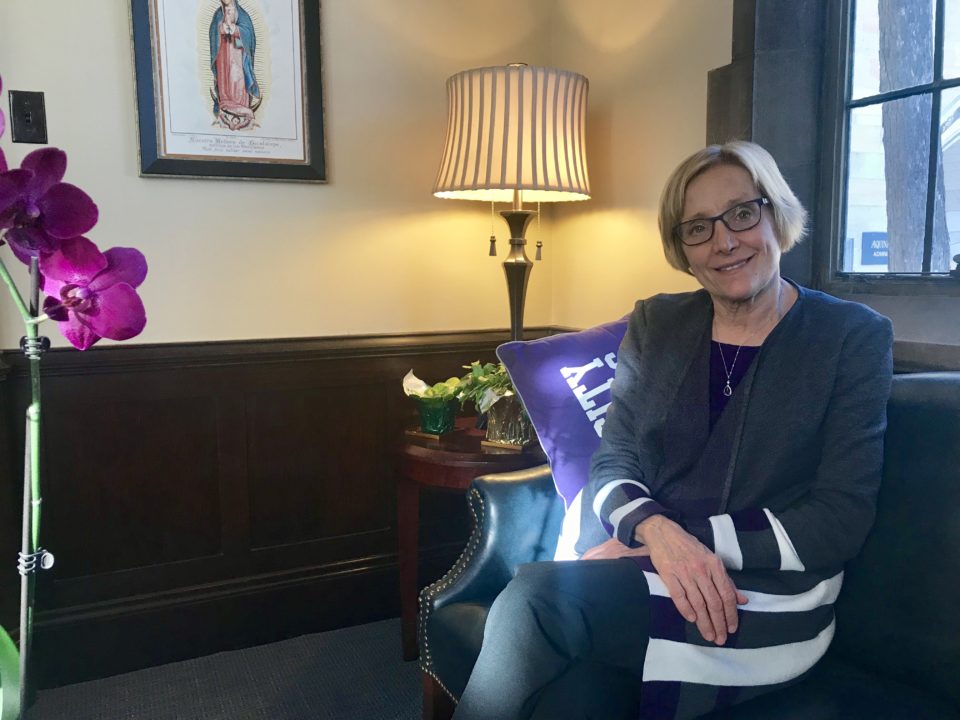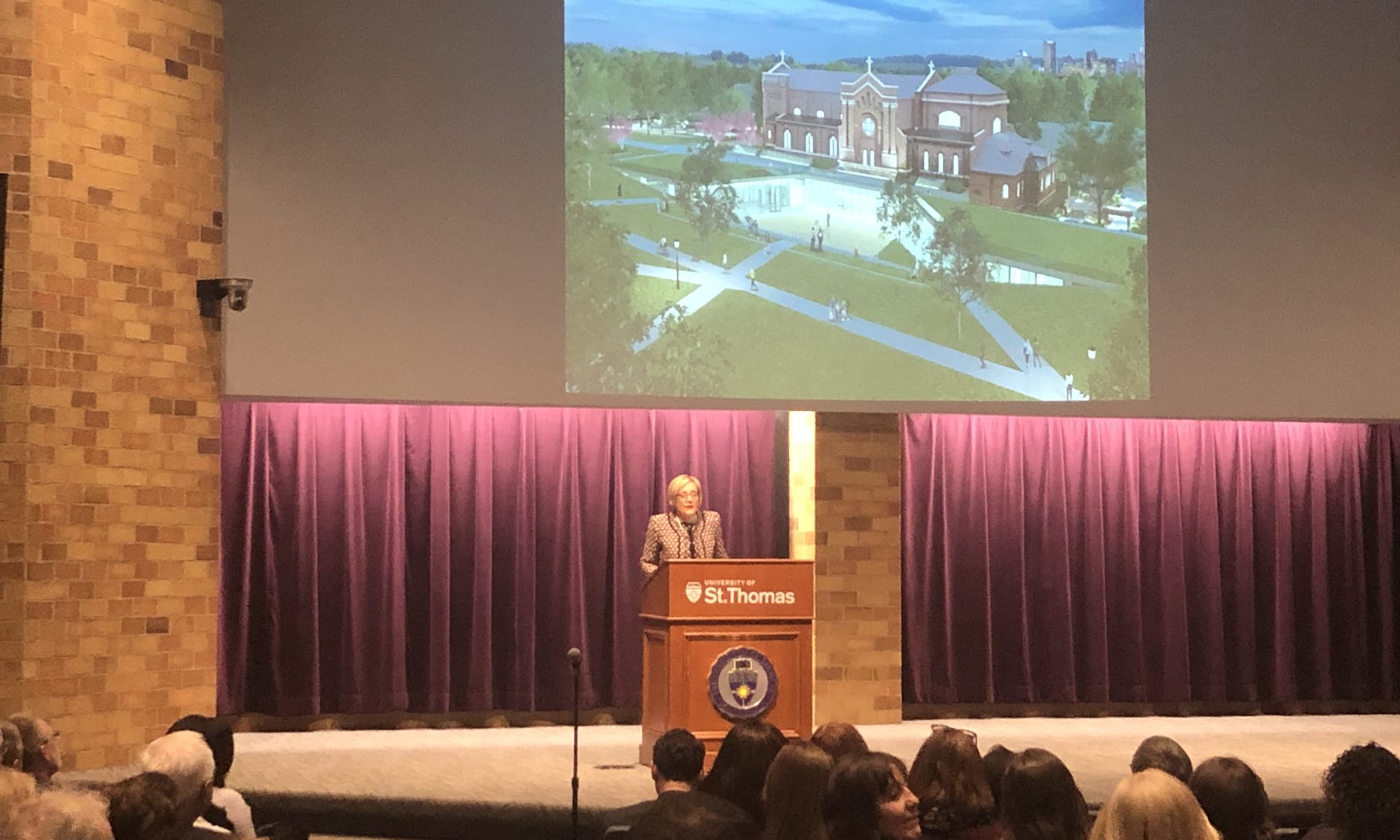
President Julie Sullivan hosts six sessions of office hours every semester to meet with students. Sullivan is the first female president at St. Thomas and is currently in her sixth year in office.
In her first “State of the University” address on Feb. 21, St. Thomas President Julie Sullivan reflected on the fall semester and explained her vision of the university’s future to hundreds in attendance.
Sullivan was unable to give her annual address at the Academic Complication last fall as she was out of the country. She used the address in the spring to bring the community together and recommit the missions and convictions of the university to the students.
“I felt like our university grew this past semester, we had challenges and I think we grew from them,” Sullivan said. “I want to recognize that.”
Those challenges included an act of racism, protests, a student’s death on campus and another student’s death in Minneapolis.
Racism on campus
Sullivan hopes the community will continue to stay focused to help prevent any future racism.
“Not only at St. Thomas, but throughout our country,” Sullivan said.
Sullivan is involved in a CEO cohort through the Amherst H. Wilder Foundation that meets monthly with facilitators to reflect on the ways that racism affects all lives. The Wilder Foundation is a nonprofit community organization that focuses on creating positive change through direct services, research and community building, according to their website.
“[Racism] goes beyond just overt prejudice actions,” Sullivan said. “It really is ingrained in how our institutions, structures and societies really have been built.”
Through her involvement, she is continuing to learn and grow in this field; knowledge that she can infiltrate into how St. Thomas is run, which later translates into the society that St. Thomas students contribute to.
“We’re about more than just going to school, it’s really being a part of the community,” St. Thomas first-year student Mason Kobilka said following the address.
Student deaths
Regarding the two students St. Thomas lost this year, Sullivan said, “Our time with students is so precious.”
She noted that she felt challenged by these deaths and that they served as a reminder of the responsibility the university holds for each student who “marches through the arches, attends our classes and becomes a part of our community.”
Sullivan urged that the community can learn from tragic events such as these, realizing how everyday is an opportunity to form a new relationship and help anyone in time of need.
The university’s future
Sullivan fixated on the strategic plan of the university, how the faculty and staff will continue to provide for the large-sized class of 2022, the plan for two-year student residency, the Enhanced Curriculum Experience and the oncoming chapel expansion.
The current strategic plan the university follows was implemented in Jan. 2015 and is titled “St. Thomas 2020.” This plan is compiled of five pillars and eight strategic priorities.
“Strategic priorities dealt with keeping our curriculum current and relevant for our students needs, and ensuring that they’re getting the skills and confidences that employers demand,” Sullivan said.
Some new majors and minors the university has instituted through this strategic plan include data analytics, civil engineering and entrepreneurship.
With one of the largest first-year classes the university has ever seen, Sullivan talked about how faculty and staff has rallied to “make sure that we could keep providing that high quality St. Thomas education to this huge class.”
Sullivan said she is thankful that so many students and families are choosing to join the St. Thomas community.
With a goal of creating a stronger community and campus involvement, Sullivan will be enforcing a two-year residency requirement on campus, but didn’t specify when the policy would begin.
She hopes this will encourage students to take more advantage of the resources provided to them through the university.
“Work is underway to ensure that we implement this requirement in a way that is equitable and accessible to all students,” Sullivan said.
Sullivan reviewed how faculty has come together to discuss the St. Thomas education and how the university can continue to prepare students with value-based education, that has always been provided, through an Enhanced Curriculum Experience.
The goal of this enhancement is to encourage students to explore learning experiences that stray from their primary majors. Opportunities of new mission-based minors, certificates or other guided experiences will be available.
Many students in attendance to the address won’t be affected by the curriculum changes, as they won’t take place until after the current junior and senior class graduate.
“I think it’s interesting to see the process of how they’re going to be handling this for incoming students,” St. Thomas junior Hannah Shogren Ssmith said.
Plans for the St. Thomas College of Health and a new academic STEAM (science, technology, engineering, arts and math) program for south campus are both underway.
Sullivan closed the address with a picture of the new chapel expansion, hoping that this conclusion left the community with a feeling of renewal and rejuvenation.
“I hope people are proud of the university,” Sullivan said. “Proud they’re here and really feel the gratitude that I have for them, what they’re doing here and feel inspired for our future.”
Taylor Shupe can be contacted through shup9397@stthomas.edu.




This is a great article about SaInt Thomas and some of its future plans! I really like the idea of a required two years on campus to get students more involved in college activities and to build a stronger college community. As a grandma to a current student (junior) and, next year, another grandchild who will be joining the Saint Thomas freshman class, I’m excited for the many new experiences that they will have. .
Finally, I’d also like to tell Taylor Shupe what a great job she did on writing this article. Accolades to you, Taylor!